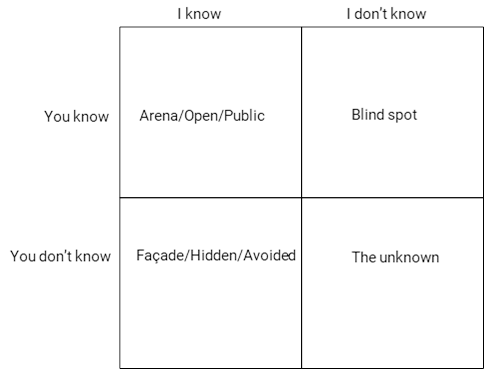Johari Window. What is it and how can it help us get to know our clients in a very different way?
Johari Window is a tool that’s really stood the test of time. Developed in 1955, by two people – Joseph Luft (1916–2014) and Harrington Ingham (1916–1995). They’ve developed something that looks so simple but enables us to do so many things. Johari helps when preparing for negotiations, putting assumptions on hold, building some questions pre-meeting, to name but a few.
The principle
Johari Window is based on the fact that there are things that I know and there are things that I don’t know. Similarly, there are things that you know, and things that you don’t know.

Joseph Luft and Harry Ingham (1955)
You can see Johari window and the four areas; the top-left says, “I know, You know”. In this area, we have some shared information that we both know. In a client meeting, it’s good to check with our client that we’ve got this right.
Next, if we go over to the top-right there’s an area with, I don’t know, You know. There are gaps in my information, so I’m going to have to ask some questions. Some salespeople choose not to ask, and decide to assume things instead. This approach usually comes back to bite them!
In the bottom-left, we’ve got, I know, You don’t know. In this case, it makes sense that I share information with you. There are risks here: I might not share the information because I’ll assume that you already know. Some call this ‘the curse of knowledge’ (once you know something you just assume everybody knows too.) The other risk is that I’ll overwhelm you with the quantity and depth of information. We need to understand what is relevant to our client.
So far we’ve seen that there’s two critical areas in those diagonals: either I need to share some information, or I need to ask for some information. In both areas, we must resist the temptation to assume. Be aware that some people may be too proud to ask.
Johari Window – into the unknown
There’s a fourth area, which is this unknown. The unknown is a brilliant area to explore. As a sales team, you can work together to discuss how you might go about doing this with your clients. If you do, you’ll certainly stand out from your competitors.
This area causes some confusion and it’s tempting to shy away from it. After all, what do we ask or say when you don’t know and I don’t know? If you think about it, this is the perfect opportunity to partner up, to form a strategic partnership, and explore this. This is where curiosity pays off: being prepared to ask the “What if…” questions, and to explore the “I wonder…” thoughts.
You don’t know, I don’t know
We were working with a local university to explore something that (without giving too much away), would be of great benefit to the UK finance sector. We didn’t know what the answer was, the Uni team didn’t know what the answer was, and the UK finance sector didn’t know what the answer was. How could they – no-one had ever done this before! We were firmly in the “I don’t know, You don’t know” area. The answer was to explore it and to work together. And not one of us had any idea about the answers that came out.
As a partnership, we got to the heart of what it was that we didn’t know. We didn’t try to understand what the answer is; we asked more questions and broke it down. We needed to ask more questions rather than making assumptions. We asked more questioning around:
What is it we’re looking to achieve?
What is it that we don’t actually know?
Where’s the value in all of this?
Breaking it down
By asking those questions, we’re making it a little bit easier to understand. Instead of trying to tackle one big thing at once, we break it down into its component parts. By answering each of the component parts, it helps us to explore and to answer that big, “I don’t know, You don’t know.”
Interested? To read more, take a look at our previous blogs, ‘What is The Psychology of Consumer Behaviour?’ and ‘Psychology of Consumer Behaviour – Assumptions’.
You may also find our free resource useful too; click on the button below to download.
Image – courtesy of Pixabay










